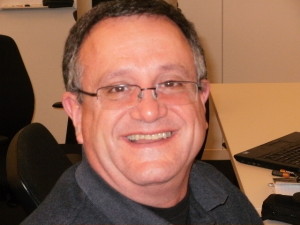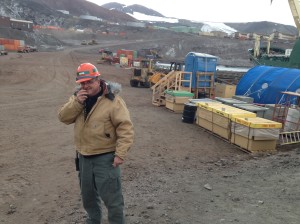Thu 5 Feb 2015
Professional Profile – Michael Grasso, CIH
Posted by admin under hygienist, industrial hygienist, occupational hygiene, Professional Profile
Comments Off on Professional Profile – Michael Grasso, CIH
I love hearing about other IH/EHS/Safety -people and their careers. They are inspiring and there are some really COOL jobs in this profession. I’d like to introduce you to Michael Grasso. He’s been on some very interesting projects, is very personable, and has some insight into the future of construction safety. 
How did you get started in IH/Safety?
I got started in IH/Safety in high school as a student athletic trainer. In college I was a health science major, the athletic training program was only opened to physical education majors. My professor for School and Community Safety encouraged me pursuit a career in safety. At this time OSHA was fairly new. The professor took me along with him when he did safety inspections on the campus. While going to the University I attended classes at the local community college in Safety and one in Industrial Hygiene. The text book was the first addition of the NIOSH white book. During the summers I worked for a public utility company as a laborer. The Safety Director bought me a copy of the “Accident Prevention Manual for Business & Industry†(NSC). My grandfather related the story of miners dying in the tunnel in West Virginia from the dust. Years, latter while reading the Washington Post, I found out it was Gauley Bridge, West Virginia.
What is your background?
I have a Bachelor’s of Science Degree in Health Science and minored in biology and psychology. I did my student internship in the corporate safety office of an electric and gas Utility Corporation and an internship with the county health department in the environmental health division. Upon graduating from college worked as a laborer for a pipeline company. The majority of my career has been in a construction related field. Starting off as a Safety and Health technician advancing by changing jobs to Safety and Health Manager and finally to a Corporate Safety Director position for a design-build firm. At this firm I was instrumental in building the organizations safety and health program and culture from ground zero. In a short period of time the company won the AGC Contractor of the year award, had one VPP site, several SHARP projects and won numerous safety awards including the Golden Hardhat award from the USACE.
What do you do in your current position?
Currently I am an EHS professional for a large engineering firm. I work on various wet-infrastructure projects for clients in the northeast; assist the client with developing EHS procedures in accordance with ISO 14001 and ANSI/AIHA Z10 protocols and severe as temporary EHS manager on projects. Internal client’s consultant with me on unique health and safety issues they run into as related to construction and environmental remediation projects.
Tells us your favorite project?
My favorite project is working in Antarctica for two seasons as the resident industrial hygienist. I enjoyed the beauty of Antarctica, peacefulness, history, applying my experience and the people. You can always leave Antarctica but it can never leave you.
What do you enjoy most about your career?
Knowing that you touched someone’s life, and made differences is the most satisfying aspect of my career.
What has been the most fun?
The most fun was doing the 30-hour construction awareness training for high school students who are in the building trades program. The students loved the lab as they got to wear the PPE and play with the monitoring equipment.
Anytime that was particularly difficult?
Emotionally the most difficult time for me was when a subcontractor’s hand was amputated in a concrete pump. When I went to his home with the OSHA investigator it was hard, as he was the bread winner of the family. His mother was proud that he graduated from high school, spoke good English and had a good job. This was the first serious accident that I experienced in my career.
Any hobbies/interest which makes you unique to the profession?
I collect old safety and health books. I have a collection going back to the 30’s. I have the Heinrich’s books which are difficult to read. It is interesting to compare what was going on in the 30’s and early 40’s and how OSHA incorporated them into their standard. Since college I have been a volunteer firefighter. What we learn in the fire service has applications I have used in safety and industrial hygiene. Presently, I am the fire company’s safety officer.
What books would you recommend reading? “Christ In Concreteâ€, By Pietro di Donato. “The Hawk’s Nest Incident: America`s Worst Industrial Disasterâ€, By Martin Cherniack M.D .
Words you have for those interested in construction?
It is important to know the fundamentals of construction management and the type of contract you will be working under.
Safety and health at the dirt level is where things get done and where you have the most direct influence. Saying, “Good morning Bill (or Judy)”,  or having coffee with the Project Manager goes much farther than a meeting policy statement or an EHS procedure. It shows you care. Treat others as you want to be treated goes a long away on construction projects. It is important that you can speak or understand Spanish or Portuguese. Even if you do not speak a foreign language, a smile, or a tip of the hard hat goes along way.
From an IH point what have you seen in construction that makes a difference?
Over the years heavy equipment has gotten much quitter thanks to fully enclosed cabs and engine noise reduction. Ergonomics for heavy equipment operators has come a far way in the last 10 years. It appears that many medium and large size contractors have gotten the silica message without government intervention. You see more and more workers using respiratory protection and having a hose trained on the dust generating operation. Contractors are more aware of what’s a confined space: doing monitoring, ventilation and training. Compact loaders and excavators are doing jobs once done manually. Robotic or remote operated is being used in high hazard areas. Prevention through design is slowly catching on to eliminate safety hazards. As far as health hazards go, owners, and engineers continue to specify materials potentially hazard to the health and safety of the end user, when other products are out on the market.
The number one item that is making a big difference in the construction industry is the internet. From a smartphone a trades person can find out all types of information on substances they are working or about a safety hazards.
What I see in the future for IH?
I see the future of IH playing a large role in nanotechnology. The health implications of manufacturing and using nanomaterials are not yet clearly understood. Nanotechnology may be a Pandora box.
Thank you Michael! If you have specific questions, you can reach Michael at (michaelgrasso 78 (@) hotmail .com, with no spaces).